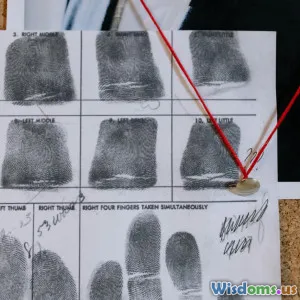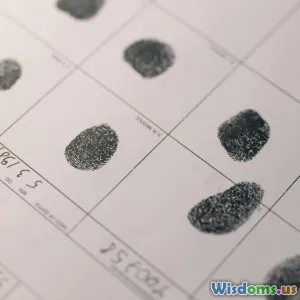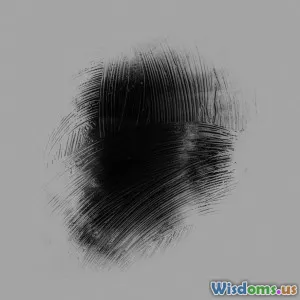
Innovations in Crime Scene Analysis
9 min read Explore groundbreaking technologies and methodologies revolutionizing crime scene analysis in criminology today. (0 Reviews)
Innovations in Crime Scene Analysis: Revolutionizing Criminology and Crime Investigation
Crime scene analysis lies at the heart of criminal investigations, a critical process that unravels mysteries hidden within the chaos of a crime. Traditionally dependent on human expertise and manual documentation methods, this vital field is undergoing a technological revolution. Innovations in crime scene analysis are not only improving the precision and reliability of evidence collection but also accelerating investigations and uncovering truths previously obscured by limitations of the past.
In this article, we'll delve into the key breakthroughs reshaping crime scene analysis—from cutting-edge 3D scanning techniques to artificial intelligence applications—and explore their profound impact on modern criminology and law enforcement.
The Evolution of Crime Scene Analysis: From Sketches to Digital Models
Historically, crime scene investigators (CSIs) relied heavily on manual sketches, photographs, and notes. While these methods laid the groundwork for accurate record-keeping, their limitations quickly became evident—vital details could be missed, and perspectives were often constrained to two dimensions.
The shift towards digital methods began with the use of high-resolution photography and videography, which provided a clearer, more permanent record, but even then, the complexity and dimensionality of crime scenes often went underrepresented.
Today, the innovations transforming crime scene analysis embrace a multidimensional approach to capture the minutest details and nuances.
Key Innovations Revolutionizing Crime Scene Analysis
3D Laser Scanning and Photogrammetry
One of the most striking technological advancements has been the adoption of 3D laser scanning and photogrammetry. Devices like the FARO Focus laser scanner or Leica’s BLK360 enable investigators to create highly detailed three-dimensional digital models of crime scenes.
These tools emit laser pulses that measure the environment with millimeter accuracy, generating point clouds—a precise digital recreation of the scene’s geometry. Photogrammetry complements this by stitching together hundreds or thousands of photographs to build accurate 3D textures.
Real-World Impact: At a 2017 murder scene in California, investigators used 3D scanning to capture spatial relationships critical in understanding the trajectory of bullets and positions of victims with unprecedented accuracy. The ability to revisit a digital scene from any angle after the fact has transformed courtroom presentations, increasing jury comprehension and confidence in evidence.
Artificial Intelligence and Machine Learning
AI applications allow for rapid and accurate processing of complex data sets collected from crime scenes. Machine learning algorithms can analyze fingerprint patterns, blood spatter, and footprints much faster than traditional methods, while consistently improving their predictive accuracy through iterative learning.
Moreover, AI-powered systems aid in the pattern analysis of evidence, linking data points across different cases that manual investigation methods might overlook.
Example: The use of AI in the analysis of shoeprints and tire tracks effectively narrowed suspect pools in multiple burglary cases in the UK, expediting investigations and increasing clearance rates.
Advanced Chemical Detection and Portable Forensics
Modern chemical analyzers, such as handheld spectrometers and portable mass spectrometers, have enabled on-the-spot detection of substances with high sensitivity. Instead of sending samples to distant laboratories, investigators now rapidly identify drugs, explosives, or accelerants right at the scene.
This immediacy leads to faster decision-making, critical in hostage situations or timed offenses.
Fact: According to the National Institute of Justice, portable forensic devices reduce turnaround times by up to 70%, significantly impacting investigation closure rates.
Augmented Reality (AR) and Virtual Reality (VR) for Reconstruction
AR and VR technologies offer immersive crime scene reconstructions, providing law enforcement and legal professionals new perspectives on evidence layout and timelines.
Immersive VR rooms can place investigators or jurors inside a virtual crime scene, enabling them to explore spatial relationships interactively.
Insight: A pilot program in Sweden showed that jurors exposed to VR crime scene presentations had a better grasp of the case details and were more confident in their verdicts.
Drone Technology for Macro and Micro-Level Mapping
Drones equipped with high-resolution cameras capture aerial views and intricate details of large or hard-to-access crime scenes. This is particularly useful in outdoor crime scenes, accident sites, or large-scale events like multiple-victim incidents.
By integrating drone data with GIS (Geographic Information Systems), investigators can analyze environmental factors influencing the crime.
Case Study: After a mass shooting event, drones mapped the event perimeter and victim locations, providing swift, accurate spatial data that informed emergency response and forensic analysis.
Practical Benefits and Challenges
Enhanced Accuracy and Preservation
The transition to digital and AI-enhanced crime scene analysis enhances evidence integrity and minimizes human error. Digital archives resist deterioration—or accidental alteration—preserving forensic data indefinitely.
Accelerated Investigations
Innovative tools drastically reduce the time required to document and analyze scenes, allowing for prompt law enforcement responses, which is critical for preventing further crimes.
Training and Standardization
These technologies support standardized procedures and training, reducing disparities in investigative quality across jurisdictions.
Challenges
However, these innovations come with hurdles, including the need for substantial financial investment, specialist training, data privacy concerns, and legal standards adaptation to digital evidentiary materials.
The Road Ahead: Integrating Innovation with Human Expertise
While the technological landscape of crime scene analysis advances rapidly, human expertise remains indispensable. These tools complement but do not replace the nuanced judgment and field experience of forensic professionals.
Future developments may include deep learning algorithms capable of automating entire workflows, wearable devices offering real-time analytics to investigators, and blockchain-based evidence logging to safeguard integrity.
The synergy between cutting-edge technology and skilled investigators promises a new era of justice—one where crimes are solved faster and verdicts rest on unparalleled factual clarity.
Conclusion
Innovations in crime scene analysis are revolutionizing criminology and criminal investigations by providing more precise, comprehensive, and accessible evidence assessment tools. 3D scanning, AI, portable forensic devices, AR/VR, and drones have fundamentally transformed how investigators collect, analyze, and present evidence, increasing efficiency and justice quality.
As these technologies mature and become more widely adopted, the potential to solve crimes with higher accuracy and speed emboldens the global pursuit of justice. Embracing these innovations is essential for modern law enforcement agencies aiming to stay ahead of evolving criminal tactics and deliver truth with irrefutable clarity.
Understanding and integrating these cutting-edge techniques into crime scene analysis will be crucial for legal practitioners, forensic scientists, and investigators striving to make the world safer and judicial processes more transparent.
By continually exploring and applying the latest innovations in crime scene technology, society advances not only in forensic science but also in the fundamental values of justice and public trust.
Rate the Post
User Reviews
Popular Posts



















